List of Hindu festival names, dates, information, significance, importance, details
Namaste friends, how are you doing today? Welcome to #BhagavanBhakthi website / blog.
Bhagavan Lord Sri Vishnu (Krishna) (Rama) blessings to you and your family!
In this website / blog, you will always learn about #Hinduism #Sanskrit language.
Also subscribe to my YouTube channel from this link #BhagavanBhakthi to view videos about #Hinduism #Sanskrit language.
Just before going to “List of Hindu festival names, dates, information, significance, importance, details“, let us have some brief information.
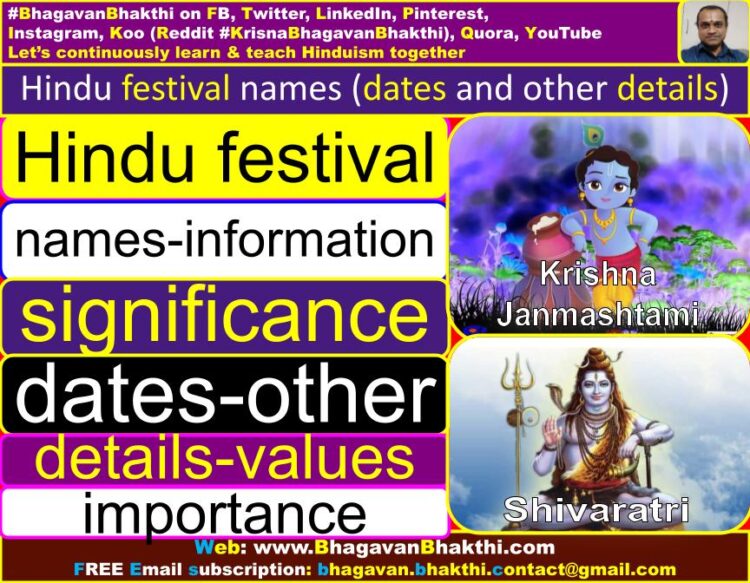
Hindu Sanatana Dharma is just amazing. We have festivals throughout the year. Starting from Chaitra masam (month) up to Phalguna masam (month), we will be celebrating utsavs (festivals) for entire year.
All the Hindu festivals are celebrated all over India and few other parts of the world with great bhakti (devotion), pomp and grandeur.
On the Hindu festivals’ days, the deity of Lord Sri Krishna / Sri Hari / Sri Rama is decorated in great magnificent dresses as the avatars of:
Lord Sri Vishnu like Lord Sri Mastya, Lord Sri Kurma, Lord Sri Varaha, Lord Sri Narasimha, Lord Sri Vamana, Lord Sri Parashurama, Lord Sri Rama, Lord Sri Krishna etc.
Lord Sri Krishna decorated as Arjuna’s charioteer (that is, as Lord Sri Parthasarathi) is especially very attractive and eye-catching to view.
Lord Sri Krishna temples is a hive of activity throughout the 12 months of the years (that is, on all the 365 days, throughout the year).
Following is a list of the very important and holiest festivals celebrated with great pomp and ceremony by the bhaktas (Devotees) of Lord Sri Vishnu / Lord Sri Hari / Lord Sri Rama / Lord Sri Krishna.
List of Hindu festival names (dates and other details) is as given below:
Ugadi / Yugadi : Ugadi / Yugadi is the first day of the Hindu panchanga and is the new year for the Sanatana Dharmis. Yugadi means, Yuga = a yuga / era, adi = start.
This is celebrated on the first day of the month of Chaitra masam (month) is the real and correct New Year’s day according the Hindu chandramana panchanga / lunar calendar.
Similarly, the first day of the month of mesha is the new year according to the Suryamana panchanga / solar calendar.
A tray containing a coconut, fruits, jewels, and a mirror is placed in front of the deity of Lord Sri Krishna on the previous night.
The next morning, these auspicious objects are the first things seen by Lord Sri Krishna. This ritual is known as the darshana of kaNi.

Matsya Jayanti : On Shukla paksha tritiya / third day of the Chaitra masam (month) Lord Sri Vishnu took the avatar of Sri Matsya, the fish incarnation.
On this day the icon of Sri Krishna is decorated with an armor resembling a fish (in temples like Sri Udupi matha).
Varaha Jayanti : Lord Varaha Jayanti (birthday) is celebrated on the tritiya tithi (third day) in the Shukla Paksha (Bright fortnight) of the Bhadrapada masam (month), the boar incarnation.
Sri Rama Navami : Lord Sri Rama was born on the shukla paksha, navama (navami) tithi of Chaitra masam (month).

On this day the deity of Lord Sri Krishna is decorated with bow and arrow instead of the usual churning rod and rope (in temple like Sri Udupi matha).
Hanuman Jayanti : On the Purnima tithi of the month of Chaitra, known as the Chitra Purnima, special dishes are offered to the icon. It is a day of festivity at the shrine of Lord Hanuman.
Since Sri Hanuman is an avatar of Sri Vayu Deva, Sri Hanuman is also known as Sri Mukhya Prana Deva.
Kurma Jayanti : The Dvitiya tithi in the shukla paksha of the month of Vaishakha is celebrated as Sri Kurma Jayanti.
On this day the deity of Lord Sri Krishna at the Udupi matha is decorated as a Sri Kurma / tortoise.
Akshaya Tritiya : Akshaya means which never gets exhausted or which never has the end (eternal / undying).
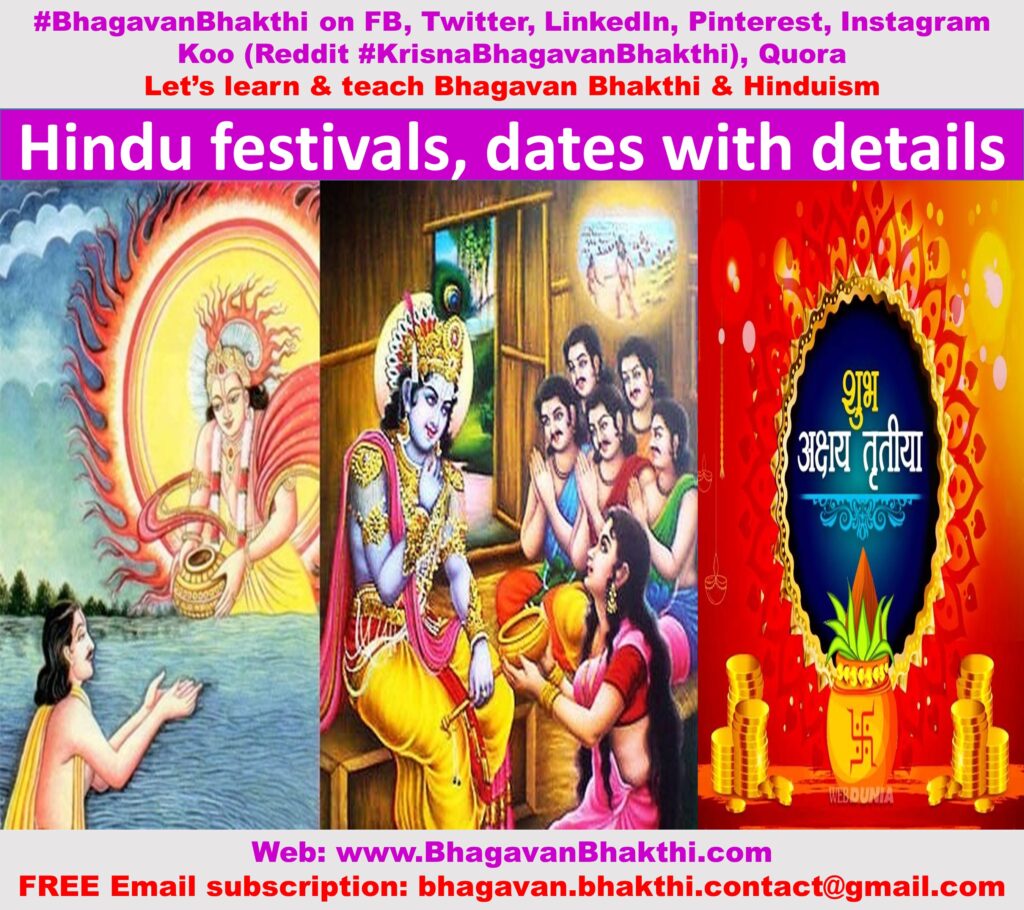
Tritiya means the third day. For this Akshaya patra which is given to Pandavas was giving whatever they want on daily basis.
The tritiya tithi on the Shukla paksha of Vaishakha masam (month) is the day of the incarnation of Lord Sri Vishnu as Lord Sri Parashurama Deva.
The Lord Sri Krishna’s deity of the Udupi matha is decorated with an axe, to depict him as the Sri Prashurama Deva.
Vasantotsava : Vasanta means spring and utsava means festival.
From Akshaya Tritiya to the Purnima tithi of the month of Vaishakha a special vasantotsava, or the festival of spring, is arranged every day at many Sri Hari temples.
Vasanta Dvadashi / Sri Veda Vyasa Ji birthday : On a Dvadashi tithi in the shukla paksha Vaishakha masam (month), Lord Sri Vishnu took the incarnation of Lord (Sage) Sri Veda Vyasa Ji through Satyavati Devi.
Narasimha Jayanti : Lord Sri Vishnu took the avatar of Lord Sri Narasimha on the chaturdashi tithi in the shukla paksha of Vaishakha masam (month).
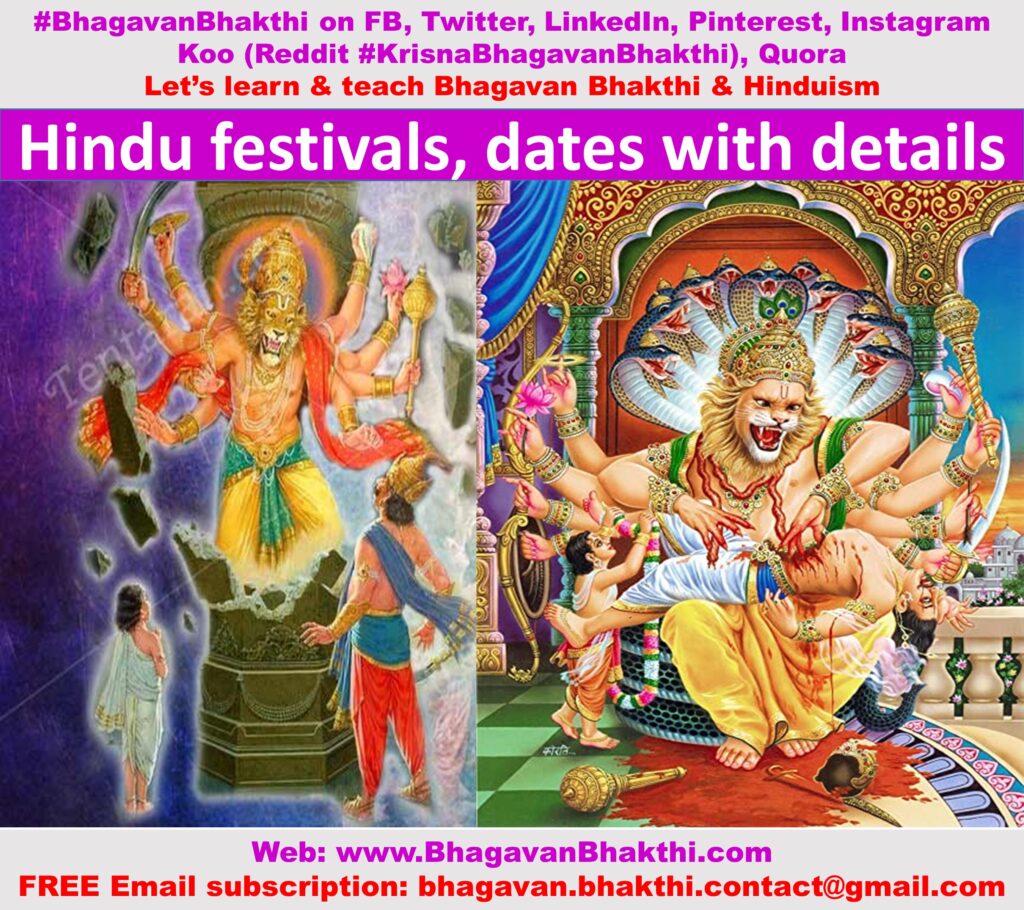
Bhagirathi Jayanti (Ganga Jayanti) : Sri Ganga Devi came down as Sri Bhagirathi on the dashami tithi in the shukla paksha month of JyeshTha.

It was on this day that the river Sri Ganga Devi took birth (came down to the earth) at the request of Bhagiratha (hence the name, Bhagirathi).
Prathama Ekadashi (Prathamaikadashi) : The Ekadashi tithi in the shukla paksha of the month as AshaDha is known as Prathamaikadashi, or Shayani Ekadashi.
The period covering the next four months is known as the chaturmasya.
During this period, Lord Sri Vishnu reposes on His Shesha-bed (Adi Shesha Naga), in what is known as the ‘yoga-nidra’ (literally meaning “the sleep of yoga”).
Chaturmasam (Four months) : On the Purnima tithi of AshaDha masam (month), commencement of chaturmasya or staying in a fixed place for a period of four fortnights starts.
During this Chaturmasa, Lord Sri Rama Chandra Prabhu was staying at the Sugriva place, as it is the season of rains.
Nag (Naga) Panchami : This is celebrated on the panchami tithi of the shukla paksha of the month ShravaNa.
The main deity worshipped on this day is Sri Adi Shesha Naga, secondly it is Sri Kartikeya (son of Lord Shiva) and third deity is Sri Vasuki Naga (sarpa that is on the neck of Lord Shiva).
Upakarma : The janeev / janevara / yagnopaveetham ceremony for those belonging to the clan known as Rig Vedis takes place on the shravaNa nakshatra day in the Simha masam (month).
Those who belong to Yajur Veda branch celebrate this on the Purnima tithi of the month of Simha masam (month).
On the day of the hasta nakshatra in the Simha masam (month) the men belonging to Sama Veda branch celebrate their upakarma. This usually comes in the lunar month of Bhadrapada.
Hayagriva Jayanti : Purnima tithi of ShravaNa masam (month) is celebrated as Sri Hayagriva Jayanti (an avatar of Lord Sri Vishnu).
Dadhi vrata starting : From Dvadashi tithi in the shukla paksha of ShravaNa masam (month) to the Dvadashi tithi of the shukla paksha of Bhadrapada masam (month) people observe dadhi vrata.
During this time the devotees abstain from eating curds.
Sri Raghavendra Swamy Jayanti : The jayanti of Sri Raghavendra Swami falls on the Dvitiya tithi of the Krishna paksha in the ShravaNa masam (month).
Lord Sri Krishna Janmashtami : On Ashtami tithi in the Krishna paksha of the Simha (Shravana) masam (month) is the day of avatar of Lord Sri Krishna.
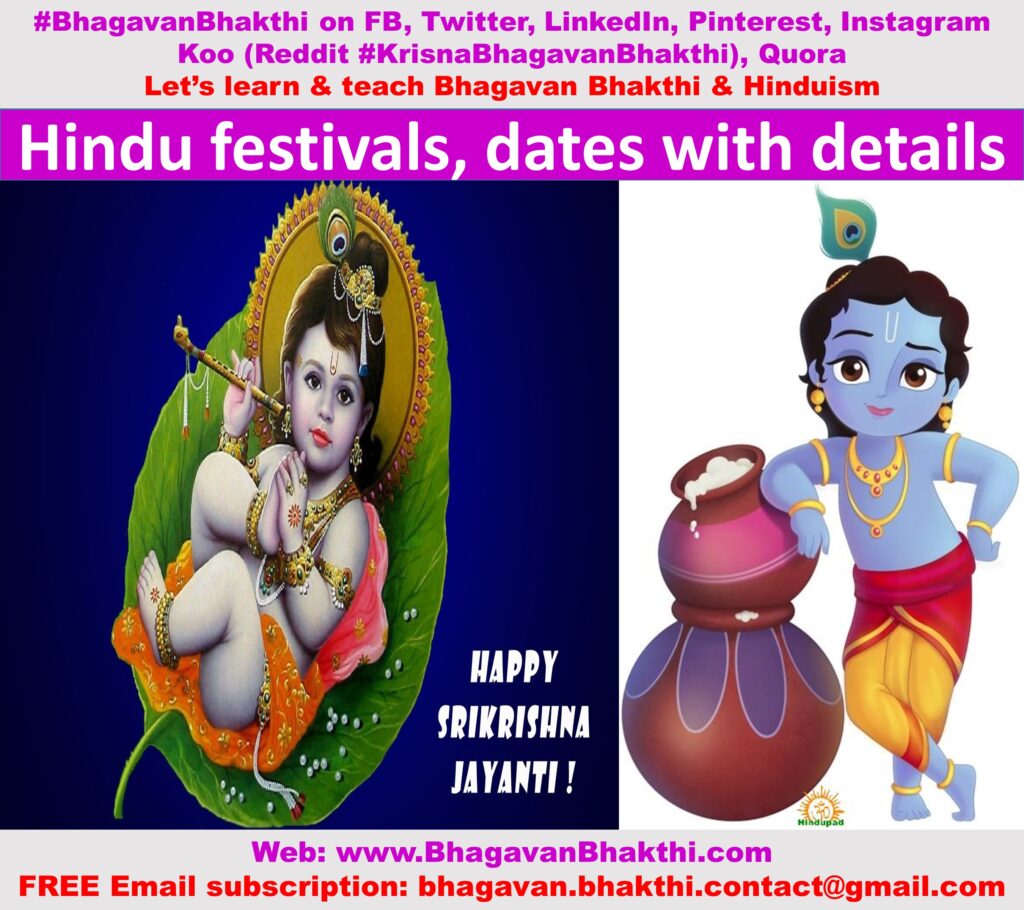
If the RohiNii star is on at midnight the day is known by the name Sri Krishna JanmashhTami otherwise it is called as Sri Krishna Jayanti. This tithi / day will fall in the month of shravaNa.
Sri Ganesha Chaturthi : On chaturthi tithi in the shukla paksha of the Bhadrapada masam (month) is celebrated as the festival of Lord Ganesha.
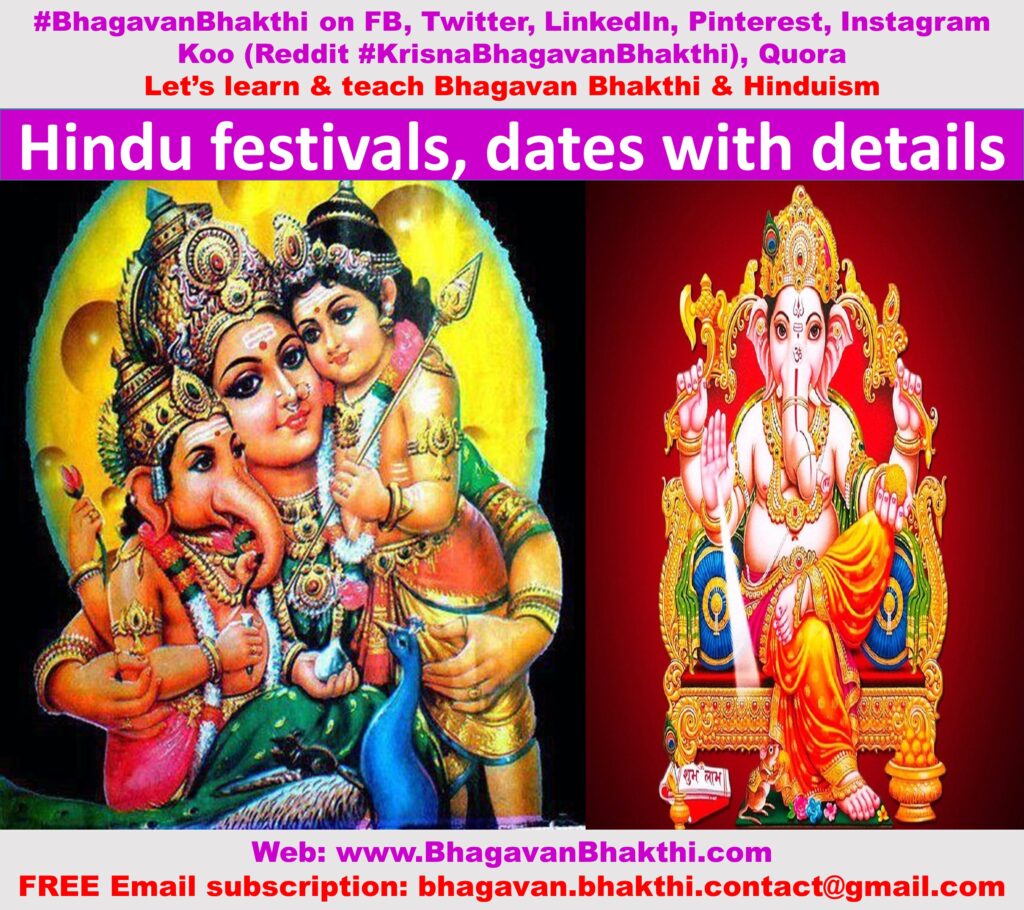
Varaha Jayanti : The panchami tithi in the shukla paksha of Bhadrapada masam (month) is celebrated as Sri Bhu Varaha Jayanti.
Kalki Jayanti : The shasTi tithi / sixth day in the shukla paksha of Bhadrapada masam (month) is celebrated with special services to Lord Sri Vishnu in the form of Sri Kalki.
On the same day Lord Sri Vishnu will take avatar on this earth.
Vamana Jayanti : It was on the Dvadashi tithi in the shukla paksha of Bhadrapada masam (month) that Lord Sri Maha Vishnu took the incarnation of Lord Sri Vamana on this earth.
Sri Ananta Chaturdashi : The chaturdashi tithi in the shukla paksha of the Bhadrapada masam (month) is known as anantana vrata.
Lord Sri Ananta Padmanabha is invoked in a pot filled with water and decorated with coconut and flowers.
Navaratri : Navaratri means, nava = nine and ratri = nights. From the Padya / Ekam tithi to the navami tithi in the shukla paksha of Ashvayuja masam (month), the Navaratri is celebrated.
Pustaka puja : The Great Sanatana Dharma grantas are worshipped during the period of the mula nakshatra to shravaNa nakshatra,
commencing from the shasTi or saptami tithi of navaratri and going up to the navami or dashami tithi in that fortnight. This is celebrated in the Ashvayuja masam (month).
Bhima Amavasya : This day is celebrated on the last day of the shukla paksha, shravaNa masam (month), that is on the Amavasya day.
Vijaya Dashami : Vijaya means victory and Dashami means the tenth day of the month. This is the day when Sri Rama Chandra Prabhu won over the asura Ravana.
This day is celebrated in the Ashvayuja masam (month) on the dashi tithi in the shukla paksha.
Buddha Jayanti and Sri Madhva Jayanti : On Vijaya Dashami day Sri Buddha jayanti is celebrated. Lord Sri Vishnu is worshipped in the the form of the Sri Buddha on this day.
Also on this day, Sri Madhvacharya Ji was born in Udupi in a place called Pajaka Kshetra on the same Vijaya Dashami day.
Deepavali : Deepavali means, Deepa = lamps and vali = lighting and celebrations. The great ceremony begins on the Dvadashi tithi of the Krishna paksha of the ashvayuja masam (month).
I have written the details of this Great Festival in this post. You can visit this link for more information:
Deepavali significances full explanation
Sri Tulasi puja (chota / chikka Deepavali / Diwali)
The great ceremony begins on the Dvadashi tithi of the Krishna paksha of the ashvayuja masam (month).
I have written the details of this Great Festival in this post. You can visit this link for more information.
Krishna Tulasi Vivaha and other significances
Subramanya ShashTi / ShashTi : On ShasTi tithi of the shukla paksha of Margashiirsha masam (month) it is celebrated as Subramanya shashTi or Skanda shashTi or simply ‘ShashTi’.
On this day Subramanya / Kartikeya the son of Lord Shiva took birth.
MukkoTi Dwadashi : The Dvadashi tithi in the shukla paksha of margashiirsha masam (month) is celebrated as MukkoTi Dvadashi.
Sri Datta Jayanti (Dattatreya Jayanti) : Purnima tithi in the Magashiirsha masam (month) is known as Sri Datta jayanti or Dattatreya Jayanti.
On this day Lord Sri Vishnu was “born” as Datta through mata (mother) Anasuya and sage Maharshi Atri.
Sankranti / Sankramana : Sankaranti means, San = Sun, kranti or kramana = movement.
On Panchami tithi in the Pushya masam (month), Krishna paksha Sankranti is celebrated.
Ratha saptami & BhishmashTami : The saptami tithi in the shukla paksha of magha masam (month) the Ratha Saptami is celebrated.
Following day is observed as BhishmashTami (this is celebrated on ashtami tithi).
Madhva Navami : The navami tithi of the shukla paksha of Magha masam (month) is the day on which Great Sri Madhvacharya went out to Badarikashrama and disappeared.
Sri Madhvacharya Ji is still living in Badarikashrama (Badrinath) with Lord Sri Veda Vyasa Ji and Sri Nara Narayana.
Shivaratri : The chaturdashi tithi in the Krishna paksha of magha masam (month) is celebrated as Shivaratri.
Holi and Kaam Dahan (Kama dahana) : The Purnima tithi in phalguna masam (month) is celebrated by bringing an effigy of Sri Kama Deva, the god of love, to the streets and burning it.
I have written the details of this Great Festival in this post. You can visit this link for more information:
Holi and Kaam dahan correct story
Apart from these, all Ekadashis are considered highly auspicious. I have written a post on this. For more information, you can visit this link:
Ekadashi fasting meaning and importance
More information will be added to this on regular basis, please visit after some time to know more information.
To watch videos on #Hinduism #Sanskrit language, SUBSCRIBE to my YouTube channel from this below link:
#BhagavanBhakthi YouTube channel
Continue reading to know about “Lord Sri Vishnu information (facts) (details)” from here:
Lord Sri Vishnu information (facts) (details)
Continue reading to know about “Lord Shiva (full) information (facts) (details) – Part 2 of 2” from this below link:
Lord Shiva (full) information (facts) (details) – Part 2 of 2
To watch about “Lord Sri Krishna information” YouTube video, click the below YouTube video link:
Lord Sri Krishna information (YouTube videos)
To read about “Lord Sri Krishna information (website / blog reading)“, please click the below link:
Lord Sri Krishna information (website / blog reading)
Dear friends, if you need any clarifications about this post, kindly let me know, I will definitely try to answer all of them.
Also your one LIKE, one COMMENT, One Share, one SUBSCRIPTION is highly important.
This will help to know the quality of this content and also it will be helpful to know if any improvements is required for the content.
If you feel this content is useful to you and has helped you to improve your knowledge, kindly share this with your well-wishers.
Because “SHARING MEANS CARING”.
To receive FREE EMAIL SUBSCRIPTION about #BhagavanBhakthi, you can send an email to [email protected] from your email ID.
NAMASTE!
Sri Gurubhyo Namaha
Sri Krishnaaya Namaha
Sri Krishnaarpanamastu
Share in Social Media